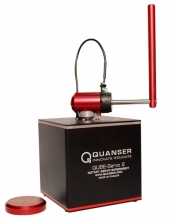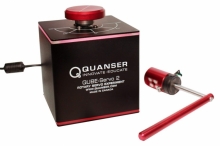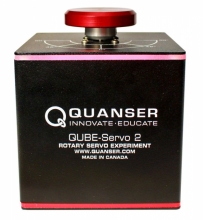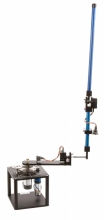QUBE-Servo 2



The Quanser QUBE™-Servo 2 is a fully integrated, modular servomotor lab experiment designed for teaching mechatronics and control concepts at the undergraduate level.
The Rotary Double Inverted Pendulum module is ideal to introduce intermediate and advanced control concepts, taking the classic single inverted pendulum challenge to the next level of complexity. You can use it to demonstrate real-world control challenges related, for example, to takeoff stabilization of a multi-stage rocket. The Rotary Double Inverted Pendulum module attaches to the Rotary Servo Base Unit.
The Double Inverted Pendulum module is composed of a rotary arm that attaches to the Rotary Servo Base Unit, a short 7-inch bottom blue rod, an encoder hinge, and the top 12-inch blue rod. The balance control computes a voltage based on the angle measurements from the encoders. This control voltage signal is amplified and applied to the Servo motor. The rotary arm moves accordingly to balance the two links and the process repeats itself.
The following additional components are required to complete your workstation, and are available separate:



The Quanser QUBE™-Servo 2 is a fully integrated, modular servomotor lab experiment designed for teaching mechatronics and control concepts at the undergraduate level.

The Rotary Double Inverted Pendulum module is ideal to introduce intermediate and advanced control concepts, taking the classic single inverted pendulum challenge to the next level of complexity. You can use it to demonstrate real-world control challenges related, for example, to takeoff stabilization of a multi-stage rocket. The Rotary Double Inverted Pendulum module attaches to the Rotary Servo Base Unit.

The Rotary Flexible Link module is designed to help students perform flexible link control experiments. The module is designed to be mounted on the Rotary Servo Base Unit. This experiment is ideal for the study of vibration analysis and resonance and allows us to mimic real-life control problems encountered in large, lightweight structures that exhibit flexibilities and require feedback control for improved performance. The experiment is also useful when modeling a flexible link on a robot or spacecraft.
